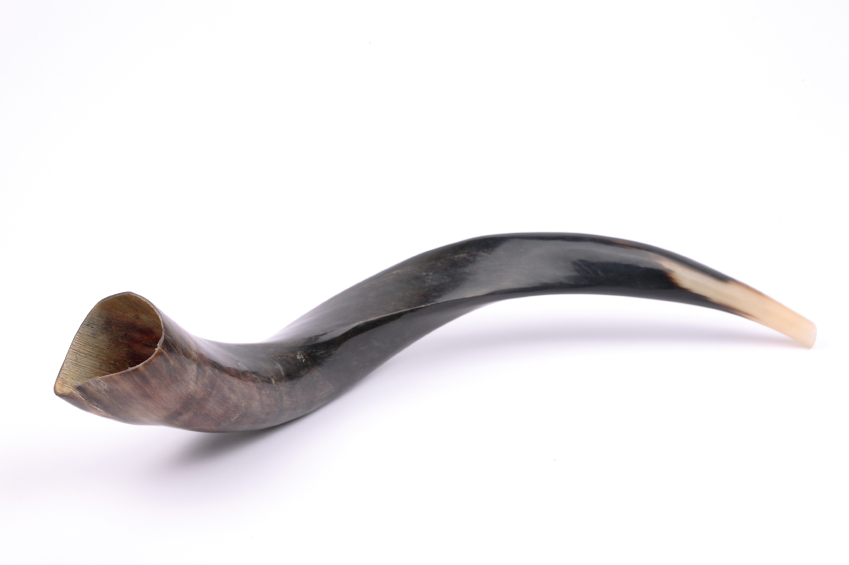We did not blow the Shofar on the last day of Elul, the morning before Rosh HaShanah, in order to “confuse the Satan.” Perhaps this means that the Satan would think that “they’re finished blowing, and have nothing left for the Day of Judgment.” But we say “Ashrei HaAm Yod’ei Teruah!” “Fortunate is the People who understand the power of the Shofar!”
 We can differentiate between the Shofar of Elul, which is primarily a wake-up call, “Wake up, you sleepers, from your sleeping, and those of you who are in deep slumber, arouse yourselves from your slumber. And Return to Hashem!” By the end of Elul, we are, hopefully, fully awake and ready, or at least aware, of the “Fear and Trembling” required by Rosh HaShanah.
We can differentiate between the Shofar of Elul, which is primarily a wake-up call, “Wake up, you sleepers, from your sleeping, and those of you who are in deep slumber, arouse yourselves from your slumber. And Return to Hashem!” By the end of Elul, we are, hopefully, fully awake and ready, or at least aware, of the “Fear and Trembling” required by Rosh HaShanah.
The basic combination of sounds produced by the Shofar both during Elul and on Rosh HaShanah is “Tekiah-Teruah-Tekiah.” The “Tekiah” is a straight sound, a sound of attention, a call to gather. It’s possible that the most important sound in Elul is the “Tekiah,” the call to attention. Whereas, the central sound bearing the Rosh HaShanah-specific content is the “Kesseh,” the Hidden One, the sound concealed within two “Tekiot;” namely, the “Teruah.”
Unfortunately, the meaning of the “Teruah” is unclear. The Talmud considers three possibilities for its meaning: the 1) “Shevarim,” 2) the sound which we call the “Teruah,” and 3) the sound which we call the “Shevarim-Teruah.”
The Broken Sound
The “Shevarim” is, as its root, “shin-bet-resh,” “to break,” implies, a sound of brokenness. It is a sigh, a sound of despair. The despair is over the distance felt from Hashem, caused by our sins. A possible reason that the sigh has to be within the two “Tekiot” is that a sigh is considered destructive; it can break the body. It emanates from the heart and crushes the heart. Without the uplift of the “Tekiot,” the effect would be to leave us in a state of depression.
The Wailing Sound and the Sighing-and-Wailing
An alternative for the meaning of the “Teruah” is the sound [which we, confusingly, call the “Teruah”] of wailing. It is the undulating sound produced by mourners, especially women, at funerals in the Middle East. This too is a sound of despair, perhaps beyond despair, when all hope is lost. This too cannot be our final statement. Again, a lift out of that mournful attitude is required, and that lift is provided by the “Tekiot.” The third possibility is a sigh-and-a-wail, which we call the “Shevarim-Teruah,” again enclosed within two “Tekiot,” with their unique restorative powers.
Three “Additional” Rosh Hashanah Prayers
The Mussaf of Rosh HaShanah contains three remarkable “Tefilot,” or Prayers: “Malchiyot,” “Kingliness,” “Zichronot,” “Remembrances,” and “Shofarot,” “Calls of the Shofar.”
In “Zichronot,” we asked Hashem to remember, in our behalf, that ultimate act of self-sacrifice, performed by Avraham when he brought Yitzchak to the “Akeidah.” We asked Hashem to suppress his legitimate anger against us as Avraham, ready to sacrifice his son, suppressed his natural fatherly mercy. How he raised the knife until Hashem intervened at the last moment, and accepted the mysterious ram which, according to Pirkei Avot, was created on the first Shabbat Eve. And then we blew the ram’s horn.
In “Shofarot,” we were brought again to Mt. Sinai, to that awesome event when Hashem gave us the Torah, amid thunder and lightning, and the rising sound of the Shofar. When “You were revealed in Your cloud of glory to Your holy People to speak with them.”
And it is described there how the Manifestation of the Divine Presence, the Arrival of the Holy King, is heralded with eight Temple instruments, beginning with the “Tekiah”-call of the Shofar: “Praise Him with the blast of the Shofar; praise Him with lyre and harp. Praise Him with drum and dance; praise Him with organ and flute. Praise Him with clanging cymbals; praise Him with resonant trumpets. Let all souls praise G-d, Halleluyah!” (“Tehilim”/Psalms 150)
The motto of Rosh HaShanah, the Day of Judgment, was declared: “Blow the Shofar at the time of the New Moon; when the moon is hidden, to announce a joyful day for us, for it is a decree made known to Israel; a Day of Judgment for the G-d of Jacob.” There is a Law and there is a Judge! There is an infinitely moral basis for life: G-d’s Law for Man, the Torah. We fear, and we tremble, but we rejoice!
We prayed, “Our G-d and the G-d of our fathers, sound the great Shofar for our freedom,..Bring us to Zion, Your City, in glad song, and to Yerushalayim, home of Your Temple, in eternal joy.”
The End of Neilah
And, at the end of Neilah, with the closing of the Gates of Prayer as Yom Kippur draws to a close, the Service rises to a crescendo:
We declare in unison, “Hear O Israel, the L-rd is our G-d; the L-rd is One!”
Then three times, “Blessed is the Name of His Glorious Kingdom for all Eternity!”
And finally, seven times, “The L-rd is G-d!”
We acknowledge the departure of the “Shechina,” the Divine Presence, with a “Tekiah Gedolah!” a Great “Tekiah,” a long straight blast of the Shofar. At this time, there is no room for sighing or wailing. We have hopefully been forgiven, and our sins have been atoned for. We look forward to our Redemption; May it come in the blink of an eye!